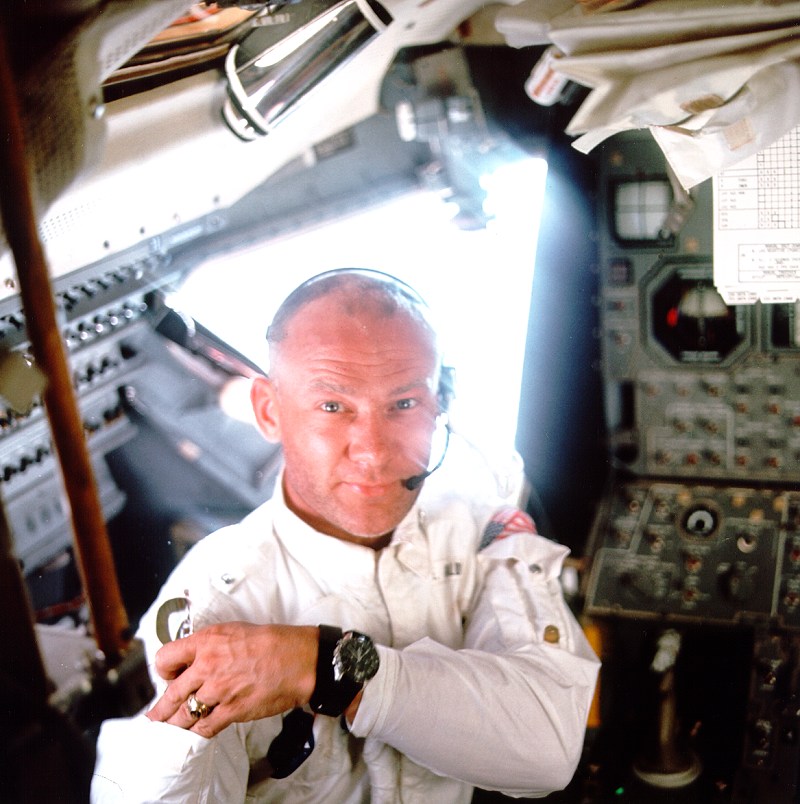On July 20, 1969 [40 years ago today] the Apollo 11 Lunar Excursion Module [LEM] gently touched down on the surface of the moon. Contained inside of its cramped quarters were Neil Alden Armstrong, and Edwin Eugene "Buzz" Aldrin Jr. with Michael Collins piloting the Command Module over head in the moon's orbit. There is no doubt in any person's mind that these, along with many other people in NASA's past and present, are truly heroes that can be looked up to with pride.
Among the many articles making the 4 day trip to the moon was the now famed Omega Speedmaster Chronograph [model #: 3570.50]. From that day forward this popular timepiece would come to be known as "The Moon Watch" and Omega makes no bones about marketing it as such. The watch first came into production in 1957 and is still available today with little to no modifications from the original design.
The funny thing is the Omega Watch Company had no idea that NASA was testing this watch to be used for space travel. NASA officials covertly bought several brands of chronograph watches in retail stores and began to put them through rigorous stress tests to see which would survive the hard trip and atmosphere in outer space. On March 1st, 1965 the Omega was proclaimed the winner and was adopted by NASA as the only “Officially Certified Wristwatch For All Manned Space Missions.”. It wasn't until Edward White wore a Speedmaster on his wrist during his space walk [the first EVA by an American] on the Gemini IV mission that Omega even found out. NASA has used the Omega Speedmaster Professional on every space mission since. It is currently one of only three watches officially rated as mission certified. Most modern wristwatches can handle the rigors of space travel and astronauts are allowed to bring any timepiece they wish along with them, but they are still given an Omega Speedmaster Professional for their missions and are expected to use them as their primary mission wristwatches.
It is widely known that Neil Armstrong is the first man to step foot on the surface of the moon. Most people, however, are not aware that the first Omega to make its way to the lunar surface was on Buzz Aldrin's wrist and not Armstrong's. Why is that? Turns out that a timing device in the lunar module was malfunctioning so Neil left his Speedmaster in the cockpit to replace the device [you can't get a better advertisement than that]. The video above shows Buzz Aldrin's first steps on the moon, and in turn shows the first wristwatch being worn on the moon as well. Unfortunately Buzz Aldrin's watch has since have been lost. While many of the watches used for manned space missions are available to view at various air and space museums across the country Buzz Aldrin's famous watch was lost in transit to the Smithsonian National Air and Space Museum and remains so to this day. So to whoever may have it...Just give it back.
Buzz Aldrin wearing his Omega Speedmaster during the Apollo 11 mission
As recently as July 19, 2009 the three Apollo 11 astronauts, along with John Glenn, appeared together at the Smithsonian Air and Space Museum in Washington DC to discuss their mission and to try to spur the next generation of NASA workers to send a human to Mars. Full story HERE.
Many may ask what the point of a manned mission to Mars is...The answer is simple: It's next. Man has always had a need to explore further and further and no other reason than that is needed. If we do send a man/woman to Mars you can bet that an Omega Speedmaster Professional will be on their wrist and now even Stephen Urquhart, current President of Omega Watches, has committed Omega to being on all manned flights from here on out.
For more information on the Omega Speedmaster and other watches worn for moon missions check out THIS SITE.



No comments:
Post a Comment